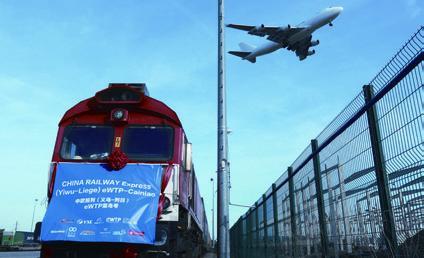Holiday Factory
2020-01-09ByLiXiaoyang
By Li Xiaoyang
While Santa Claus is commonly believed to live in the North Pole, Yiwu, a small city in Zhejiang Province, east China, has effectively developed into his warehouse. Although many people in this “Christmas town”dont celebrate the holiday, they are masters at producing all the trimmings to bring holiday cheer to customers around the world.
Yiwu has become the worlds largest production base for Christmas products, according to Cai Qinliang, Secretary General of the Yiwu Christmas Products Industry Association. According to customs data, its exports of these products totaled 1.92 billion yuan ($275 million) from January to October 2019, a year-on-year increase of 23.9 percent, up 10.6 percentage points from the same period in 2018.

With scarce farmland and low productivity, Yiwu was mired in poverty before reform and opening up began in the late 1970s, but today it is an international commercial hub of consumer goods, selling products ranging from toys and decorations to auto parts. Through market expansion and innovation, Yiwu has increasingly connected global markets with Chinese products. During the peak period, the number of booths at the Yiwu International Trade City, the primary wholesale market complex in the city, can reach about 70,000, according to its offi cial website.
Chinese-made Christmas
In recent years, freight train services linking Yiwu with cities such as Madrid, London and Prague have brought products made in the city to more European customers, notably holiday products such as Christmas trees, decorations, toys and apparels, which offer competitive prices and high quality.
Home to some 600 workshops and factories, Yiwu sells its festive wares to both developed markets in Europe and the U.S. and emerging economies in Africa and Latin America. A report by state broadcaster China Central Television (CCTV) said about 80 percent of the worlds Christmas products come from Yiwu.
More importantly, as the Yiwu China Commodity Index launched in 2006 has become a barometer of market performance, local sellers have gained the power to set product prices.
The Christmas season in the city starts as early as March every year when orders begin coming in from around the world, since it can take up to two months for shipments to reach their fi nal destinations in some of the most remote countries, Cai explained.
To receive goods in time for holiday sales, global merchants usually arrive in Yiwu months ahead of Christmas, since delivery usually ends in October.
“Right after the orders are placed, manufacturers start production. The peak production season is summer,” Cai said.
For vendors, innovative products have boosted sales. According to Lu Minying, a Christmas tree merchant who has been in the business for 17 years, her customers used to be mainly Russians, but now they come from more regions. “Our new products attracted more international customers in 2019. Compared to 2018, the volume of orders I received grew by 30 percent,” Lu told CCTV.


To improve quality and gain more profi ts, a growing number of manufacturers have started to make products from wood, cloth and steel instead of cheap, fragile materials. Some have also adopted 3D print technology and added bluetooth devices to their products. “In the past, customers could buy several Christmas ornaments made from plastic foam for about $1, while now a Christmas tree with LED lights costs over $40,” Cai said.
With the boom of e-commerce plat- forms, Yiwu merchants now receive fewer customers at their booths. But they view this as an opportunity instead of a challenge and their efforts to embrace the Internet have paid off. According to the local government, the export value of accessories from Yiwu in 2018 totaled about $2.5 billion, with some 50 percent generated by cross-border ecommerce.
Besides boosting local economic growth, the Christmas-related industry in Yiwu has brought benefits to other regions in China. According to Cai, over 80 percent of products are still handmade despite the introduction of machinery. “Since the methods of making festive products are easy to learn, Yiwus production lines have been partially transferred to remote areas in Zhejiang and other provinces, providing jobs for local low-income people,” he said.
Against headwinds
While sales were robust in 2019, many Yiwu businesses felt the pressure of rising costs and other challenges. “Although our sales volume has increased, rising material and labor costs have lowered expected profi ts,” Chen Xiaofang, another seller of Christmas products, said. Homogeneous competition has also brought the prices of old-fashioned goods down, according to Cai.
Many suppliers of Christmas products also cluster in Guangdong Province, a manufacturing hub in south China. Zhou Xiaojuan, a staff member at a market in Guangzhou, capital of the province, told the media that weak global market performance in 2019 was partially to blame for a decline in the local production of holiday goods. “Our exports of Christmas products dropped by about 30 percent due to problems in the supply chain and weak global demand,” she said.
Innovation is the only way for businesses to stand out from the competition and expand market shares, according to Cai. The potential of emerging markets can also be further tapped.“Yiwus business with countries like Peru and Guatemala is growing quickly,” he added.
Despite the distance, Yiwu is closely connected to the U.S. through exports. U.S. imports of Chinese-made Christmas products remained high in 2019. Customs data showed that Chinas Christmas exports from January to November 2019 totaled 35.73 billion yuan ($5.1 billion), with the largest proportion, or 42.37 percent, going to the U.S.
Since China and the U.S. reached the phase-one economic and trade agreement in late December 2019 after long negotiations, both Chinese festive product manufacturers and U.S. purchasing agents and customers may have a weight lifted off. The deal has come as a boon for both sides. As Cai told Global Times, U.S. companies and customers will have to pay signifi cantly higher prices if additional tariffs are imposed on imports from China, since Chinese sellers will not absorb these extra costs as more new markets emerge.
“Facing external challenges, Chinas edge lies in its complete industrial chain of Christmas products, which has allowed it to play a leading role in global markets,” he said.
